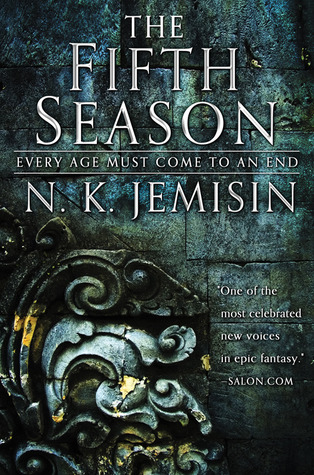Hugo Award for Best Novel, 2016
Nebula Award Nominee for Best Novel, 2016
Locus Award Nominee for Best Novel, 2016
As the mighty empire of Sanze collapses and the supercontinent known as the Stillness is torn apart, an ordinary small-town woman named Essun comes home to find her son brutally murdered, and her daughter kidnapped by her husband. Essun pursues her daughter and husband through a dying land, surrounded by massive ash plumes shooting into the atmosphere that darken the sky, initiating the next fifth season.
There is a lot I love about The Fifth Season, especially the world-building. The Stillness (think Pangea) is a fractured planet, full of seismic fault lines from previous fifth seasons, or ends of the world. These fifth seasons include the choking season and madness season (both from a volcanic eruption), the boiling season (from a hot spot eruption under a great lake) and the wandering season (from a magnetic pole shift). The culture on Stillness revolves around disaster preparedness, with massive food stores and supplies, and a healthy fear of fault lines and islands. Small communities (comms) are populated with a hierarchical caste system (innovator, strongback, breeder). Most members maintain the rigid social structure to avoid exile, which would mean certain death at the start of any fifth season.
Essun’s kind lives outside of normal society rules. As an “orogene”, she has power of over the laws of geophysics. Her people are both feared by normal human “stills”, regulated by the Imperial governments, and live as prisoners in facilities that prevent earthquakes and volcanic eruptions. Also, there’s rock people. As a side note, I also love a work of speculative fiction that explores a type of science often overlooked – planet geology (whether the Stillness is an alternate or far-future Earth or another planet altogether).
The shifting point of view defines a narrative structure that moves between three orogene women. Each at a different stage in their own life, their individual worlds are ending. The gradual unveiling of their relationship results in a jarringly shifting pace throughout most of the book, but in hind-sight, I fully appreciate the ambitious framework, which both converges and increases in complexity. The wide range of characters are all tragically flawed self-preservationists, and I see the poetry in a planet and a people under constant pressure.
Recommended as a smart, satisfying, and unique fantasy!
“Winter, Spring, Summer, Fall; Death is the fifth, and master of all.
— Arctic proverb
